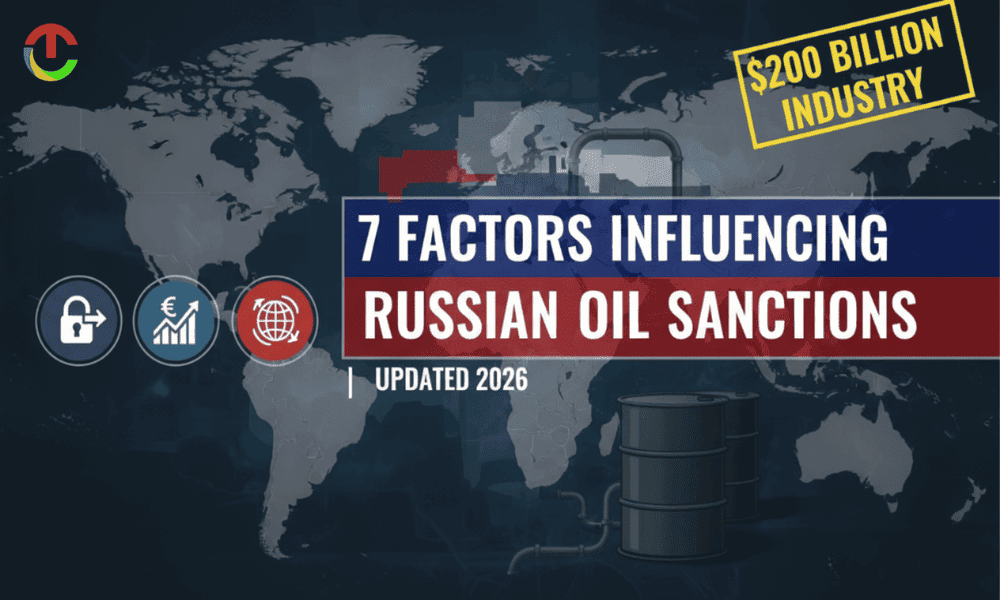As the world moves into 2026, Russian Oil Sanctions remain one of the most defining economic and political forces influencing global energy markets. Since the initial sanctions were imposed following the Ukraine conflict, their ripple effects have evolved dramatically. From shifting trade alliances to Europe’s renewable energy expansion, the international community continues to navigate a complex balance between economic necessity and political ethics.
Let’s look deep into the seven major factors shaping Russian oil sanctions in 2026 — and explore how these forces are transforming the future of energy, diplomacy, and global economics.
1. Geopolitical Dynamics Shaping Sanctions Policy
Role of NATO and EU Alliances
The driving force behind Russian Oil Sanctions lies in Western geopolitical alliances. The European Union, backed by NATO members, continues to coordinate restrictions on oil imports, insurance, and transportation of Russian crude. In 2026, the sanctions policy has become more targeted — focusing on limiting advanced technology transfers and pipeline financing rather than blanket bans.
The EU’s determination is balanced by internal divisions; countries like Hungary and Slovakia still depend heavily on Russian oil. Nevertheless, collective measures such as the price cap mechanism and shipping restrictions keep Russia’s export revenues under pressure.
U.S.–Russia Relations Post-2025
The U.S. government’s stance toward Russia remains pivotal. After a shift in administration in 2025, Washington doubled down on sanctions enforcement but also introduced flexible waivers for strategic allies like India. This dual approach reflects a pragmatic understanding of global energy interdependence maintaining pressure on Moscow without destabilizing oil markets entirely.
2. Global Energy Market Reactions
Price Caps and Export Redirections
When the Russian Oil Sanctions were first implemented, crude prices spiked globally. However, by 2026, markets have somewhat stabilized as Russia redirected exports to Asia. China, India, and Turkey have become major buyers, often paying discounted rates that still keep Russian revenues flowing. The $60 per barrel price cap has proven symbolic, as most transactions occur through opaque intermediaries or “shadow fleets.”
OPEC+ Strategic Balancing
OPEC+ — where Russia remains a powerful member — plays a balancing act. To maintain global price stability, OPEC+ has adjusted production quotas several times. In 2026, Saudi Arabia and Russia’s cooperation in managing oil supply demonstrates that, despite sanctions, Moscow retains leverage in the global energy order.
3. Economic Resilience of Russia
Despite the extensive restrictions, Russia’s economy has shown unexpected resilience. Strategic financial planning, increased domestic production, and growing trade with non-Western nations have allowed Moscow to cushion the impact.
Ruble Strength, Reserves, and Trade Partnerships
The Central Bank of Russia has fortified the ruble by increasing gold reserves and promoting ruble-based settlements in energy deals. Moreover, partnerships with China, India, and the UAE have created alternative channels for transactions, bypassing Western banking systems like SWIFT. This adaptation has limited the economic damage, allowing Russia to sustain its military and energy operations.
4. Technological and Logistical Adaptations
Use of Shadow Fleets and Crypto Payments
In the face of restrictions on maritime insurance and payment systems, Russia has built a “shadow fleet” — vessels with obscure ownership and non-Western insurance. These ships transport oil to Asia and Africa, often evading detection. Moreover, cryptocurrency payments and digital barter systems have become increasingly common, signaling a new era of decentralized oil trading.
The logistical ingenuity showcases how nations under sanctions evolve — not just economically, but technologically.
5. Energy Diversification in Europe and Asia
LNG, Renewables, and Nuclear Options
One of the most transformative effects of Russian Oil Sanctions has been Europe’s acceleration toward energy diversification. Countries like Germany and Poland have drastically increased their LNG (Liquefied Natural Gas) imports from the U.S. and Qatar. Additionally, investments in offshore wind farms and nuclear reactors have surged, marking a historic shift toward energy independence.
In Asia, India and China have also diversified — investing in renewable infrastructure while still leveraging discounted Russian oil. This dual strategy reflects an economic realism: balancing clean energy goals with affordable supply security.
6. Global Trade Realignments
Emerging Non-Western Alliances
Sanctions on Russian oil have catalyzed a new wave of global trade alliances. The BRICS+ bloc, including Saudi Arabia, Iran, and Argentina, has emerged as a powerful counterweight to Western-dominated systems. By 2026, these nations are developing parallel financial frameworks — including new digital currencies — to conduct trade outside of Western oversight.
India, for instance, is settling Russian oil imports in rupees through specialized banks. This shift underscores the dawn of a multi-polar trade era, where economic power is no longer centralized in the West.
7. Future Outlook: Sanctions and Global Stability
Potential Scenarios and Global Policy Reforms
Looking ahead, experts predict three potential paths for Russian Oil Sanctions in 2026 and beyond:
- Extended Sanctions: Western nations may continue current measures if no political reconciliation occurs.
- Gradual Easing: If diplomatic progress emerges, partial lifting could stabilize global markets.
- Complete Restructuring: A reimagined sanctions framework may focus more on individual entities rather than national exports.
Regardless of the scenario, the long-term impact is clear — sanctions have permanently altered global trade, prompting nations to innovate in policy, technology, and diplomacy.
FAQs on Russian Oil Sanctions
1. What are Russian Oil Sanctions?
Russian oil sanctions are economic restrictions imposed by Western nations to limit Russia’s energy revenues, aiming to curb its influence and military funding.
2. How have these sanctions impacted global oil prices?
Initially, prices surged due to reduced supply. By 2026, prices have stabilized as Russia found alternative buyers in Asia.
3. Which countries still import Russian oil?
India, China, and Turkey remain the largest importers, often purchasing crude at discounted rates.
4. Are the sanctions effective in weakening Russia’s economy?
Partially. While sanctions reduced Western revenues, Russia adapted through trade diversification and alternative payment systems.
5. How have European nations responded?
Europe accelerated its shift toward renewable and nuclear energy, aiming for long-term independence from Russian resources.
6. Will the sanctions end soon?
Unlikely in the short term. Policy decisions depend on geopolitical progress and global stability conditions.
CIO Times Review: The New World Energy Order
The Russian Oil Sanctions of 2026 represent more than a geopolitical tactic — they signify a global transformation. Nations are redefining trade routes, investing in renewable technologies, and challenging financial dependencies that once seemed permanent. As we move forward, energy resilience, innovation, and diplomacy will determine how the world balances ethics with economics.
Explore: The Most Influential CFOs




